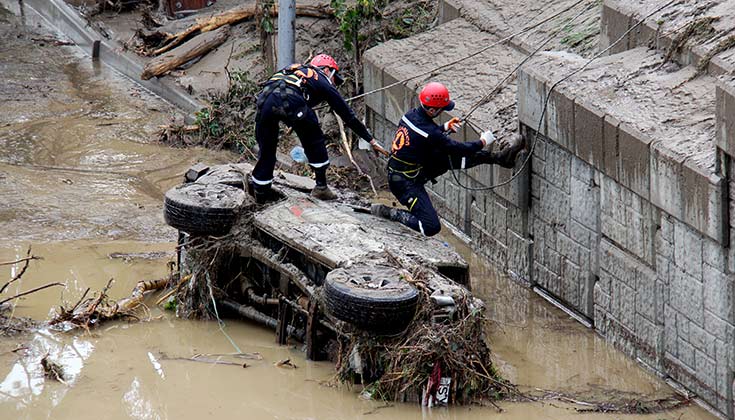CRJ 11:3 out now
This issue features reports on flooding in Georgia and the terrorist attack on a university in Pakistan, as well as a look at the self-regulating dynamic of informal settlements, and examines interoperability between emergency services in the UK. We discuss legal liabilities and response options for INGOs and NGOs whose personnel have been kidnapped and publish a feature on conflict and displacement.
In addition, advice on how to help families through the traumatic experience of identifying the bodies of their loved ones after a mass casualty attack is provided, and France’s RAID unit presents lessons learnt in mass casualty medical care after the Paris attacks.
We publish selected views from the UNISDR Science and Technology conference, and the two winning papers from the RUSI Resilience 2050 competition, which look at critical space infrastructure and security, along with an examination of the insider attack threat on interconnected systems within an age of the Internet of Things.
There's much more in this issue, due to be published soon – read on for more details.
Comment: Zain Daudpoto delves into the murky world of forestry and politics as he highlights deforestation in Sindh Province Pakistan.
Resilience in informal settlements: It is vital to understand the self-regulating dynamic of informal settlements, contends Evgenia Mitroliou of ICLEI Resilient Cities, who says people living in these communities should be actively involved in improving conditions and infrastructure.
Flood response in Georgia: Last year Tbilisi suffered devastating floods that killed 22 people and hundreds of animals from the Georgian capital’s zoo (see photo below).

Flooding in Georgia (photo: EMA Georgia)
Interoperability utopia: The word ‘interoperability’ doesn’t necessarily flow easily from the lips, which is somewhat analogous to the difficulty of achieving interoperability in practice, according to Brian Dillon.
Why do we still make the same mistakes? For decades, crisis management has been institutionalised and taught at universities. Corporations and businesses have crisis procedures in place, yet they often seem to forget this learning when crisis strikes, says Caroline Sapriel of CS&A.
INGO kidnap – a challenging new dynamic: Andrew Brown traces how fatalities and subsequent lawsuits against law enforcement and shipping companies have improved response and hostage negotiation in kidnapping and piracy, arguing that these pressures now also apply to INGOs and NGOs.
The Bacha Khan University attack: Four gunmen stormed the Bacha Khan University in Pakistan’s Khyber Pakhtunkhwa, killing 21 and injuring another 22. Luavut Zahid visits the scene and talks to those who were caught up in the attack.
Helping families through the identification process: Losing a loved one after a major disaster is inevitably traumatic. But responders and psychologists can work with families to ensure that mental scarring is kept to a minimum during the identification processes, say Erik de Soir and Emily Hough.
Earthquake public preparedness: The challenge is convincing people to take public preparedness initiatives seriously and to maintain levels of readiness during times of relative quiet, according to Gillian Dacey.
Iraq’s mental healthcare crisis: As the violence in Iraq continues, it is becoming increasingly apparent that mental health needs require careful and urgent attention according to Alys Brown of the AMAR Foundation.
Reaching a refugee camp is not the end of the trauma for those women who have been escaped enslavement by so-called Islamic State; mental health needs in Iraq need urgent attention (photo: AMAR Foundation)
Sexual violence in conflict: Understanding how, why, if and when sexual violence is used, and against who and by who, should be a central part of how we understand and respond to armed conflict, contend Dr Dyan Mazurana (Associate Research Professor, Research Director at the Feinstein International Center at the Friedman School of Nutrition Science and Policy) and Phoebe Donne.
Mass sexual abuse: A symptom of wider crisis? Lina Kolesnikova and Emily Hough say an increase in sexual attacks is in serious danger of damaging European cohesion and must be addressed, both for the sake of the victims and to avoid wider societal crisis implications.
Displacement Crisis in Europe: Much has been facilitated, enabled and achieved to respond to the emergency looming on Europe’s doorstep, explain Lisa Hastert and Marcia Kammitsi of DG ECHO. But political solutions and commitment will be required to tackle the root cause of the current crisis.
The border security paradigm: Dr Attila Freska says there are three strategic security imperatives that governments and global security leaders should implement when seeking solutions to effective control of frontiers in an age of porous borders and global radicalization.
Picking up the pieces: UXO in Syria. James Le Mesurier and Ethan Wilson describe the training and equipment planned to help the White Helmets assist the civilian communities of Syria, who are facing staggering levels of bombing with cluster munitions.
Urban services in protracted armed conflict: Some 50 million people are affected by armed conflict in urban areas, with knock-on effects that go beyond the visible signs of destruction, say Jean Philippe Dross, Michael Talhami, Evaristo de Pinho Oliveira, Javier Cordoba (ICRC); and Dr Mark Zeitoun (University of East Anglia), who call for a paradigm shift in humanitarian action.
The authors call for a paradigm shift in humanitarian response when considering urban services in areas suffering extended conflict (photo: ICRC)
Is the North Atlantic to blame for our weather extremes? Dr Aurélie Duchez and colleagues explain that when it comes to connecting the dots between climate change, extreme weather and health, many questions are still unanswered.
The Aral Sea disaster: Dr Abror Gadaev and colleagues from Uzbekistan attended the UNISDR Science and Technology conference and presented a group work raising promoting possible sustainable solutions to the Aral Sea disaster.
Simulation aids training in Japan: At the UNISDR event Dr Sonoe Mashino outlined Japanese university collaboration on a disaster nursing global leadership programme, and how they use technology during multi-site training exercises.
Europe’s emergency medical corps: This February, the EU launched the European Medical Corps, which can mobilise medical and public health teams, along with equipment, to respond to emergencies worldwide, writes Monique Pariat, Director General of Humanitarian Aid and Civil Protection (ECHO).
Mass casualty management in counter-terror operations: Emergency medical support specialists from France’s elite counterterrorist tactical unit – RAID – present some valuable lessons learnt from their responses to the recent terrorist incidents in France.

RAID's medics are embedded within France's SWAT teams. Here, they share their lessons learnt from responding to the terrorist attacks in France (photo: RAID)
CRJ R&D: First responder safety. This issue’s regular section, curated by Ian Portelli and Megan Mantaro, looks at how new technology could provide a solution to the increasing risk of firefighter bfatalities, as well as looking at a device that can sense dangerous chemicals.
Critical space infrastructure and space security: In the winning entry to the RUSI Resilience Prize, Dr Liviu Mure?an and Alexandru Georgescu look at how the complex evolution of space systems create benefits and vulnerabilities, and how the latter are likely to develop in the future.
The ripple effect of insider threat attacks: The winner of the CRJ category of the RUSI Essay competition was Ryan Meeks, who looked at resilient critical national infrastructure in the age of connected systems in the Internet of Things
Social media analysis tools: It is important to integrate social media into emergency management practices, say Hayley Watson, Susan Anson and Kush Wadhwa of Trilateral Research and Consulting. But don’t be daunted, there are tools to help.
Spatial information sharing: Ivan Baehr provides an overview of how spatial information for humanitarian response has developed, as well as the challenges in implementing this technology
Innovation in crisis management: The EU-funded Driver project aims to valorise the wealth of European innovation and science in crisis management by assessing and delivering solutions that can be used – and combined – to address crisis management.
Hover power: Dr Dave Sloggett looks at the ways that helicopters provide assistance to people in disaster stricken areas and the vital role that they perform
Legal liability in nuclear accidents Protecting the victim or the nuclear industry? Alina Alexe examines the limitations of current legislation within today’s nuclear risk landscape.

Decades after the Chernobyl nuclear disaster, many are still suffering health effects (Jan Grarup / Noor / Greenpeace)
Effective decision-making records: Previously, Roger Gomm considered the importance of maintaining clear records while responding to an incident, giving advice on how to do so. In the final part of this series, he provides some examples drawn from real life incidents.
A logbook for chaotic times: Emily Hough speaks to Patrick Lagadec about his new book, which charts the successes – and failures – of leadership in today’s volatile and ‘wicked’ crises
Looking back: The Chernobyl nuclear accident. The explosion at the Chernobyl nuclear power plant thirty years ago was – and remains to this day – the most destructive nuclear accident to occur, writes Tony Moore.
Frontline: Empowering communities. Emily Hough speaks to Dr Martina C Fuchs of the Real Medicine Foundation about her passionate belief that a paradigm shift is required in humanitarian development to empower people and communities.